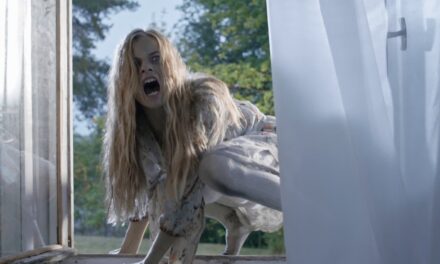A nine-year-old Benedetta (Elena Plonka) has always thought her ultimate fate would be the bride of Christ. At the beginning of the film of the same name, she goes with her family to a very prestigious nunnery, where she’s eager to serve God. Director Paul Verhoeven provides us a sight of a little girl clutching a doll of the Virgin Mary will innocence in her eyes. After an 18-year time jump, adult Benedetta (Virginie Efira) tells her mother Midea (Clotilde Courau), “I saw Jesus. He came to me. I’m his bride, am I not?” That pertinent belief drives the story of eroticism, money, power, and religious hierarchy. Verhoeven’s Benedetta is based on actual events (from Judith Brown’s 1986 book, Immodest Acts: The Life of a Lesbian Nun in Renaissance Italy). In the background of this 17th century base in a massive breakout of the plague. It’s one of the many instances of hypocrisy that the writing team of Verhoeven and David Birke shows.
One flick of fate changes everything as Bartolomea (Daphne Patakia), an impoverished woman, arrives at the nunnery trying to escape the clutches of her abusive father. Sister Felicita (Charlotte Rampling)), the very disciplined and stoic abbess, tells her it’s not a shelter. Benedetta takes it upon herself to say that her family will pay for her dowry, but it sets in motion an awakening in her. As they grow closer, Bartolomea sets off romantic feelings inside Benedetta, which she automatically calls sin. Verhoeven uses these visions in both a vivid and slightly comical way. At one point, Benedetta dreams of herself getting attacked by a group of marauders, and Jesus comes in and slays them like an action hero. Other times, as Bartolomea and Benedetta get closer, the intimacy is depicted as a snake or something of that ilk.
A lesbian relationship begins between Benedetta and Bartolomea, and Benedetta embraces physicality to get closer to God, which is powerfully brought to life on screen by the performances of Efira and Patakia. Meanwhile, Sister Felicita suspects something is going on between them and implicates that Benedetta is faking claims of stigmata. There’s a cat-and-mouse game of one-upmanship, power struggles, and secrecy that is going on within the nunnery. After the halfway point, Benedetta embraces its eroticism and also plays out like a political drama.
It seems like Benedetta is an unreliable narrator, but with religious claims, sightings or beliefs have singular experiences. Verhoeven tries to leave a bit to the imagination in both ways – perhaps the phenomenon is all a hoax to gain power. Maybe they are indeed happening. Benedetta’s belief is unshakable, even maniacal at times. Efira can sandwich the stewardship of a serving something higher than her and the craving of physical and powerful pleasure together so that you are constantly guessing. Using how her visions become even grandiose against the decay of the bubonic plague on the outside will make for many meaningful discussions.
Once the tacky, luxury indulgent, and cold Nuncio of Florence (Lambert Wilson) comes into play, this all comes to a head. Like Verhoeven’s previous movies, Basic Instinct and Showgirls, the director is not afraid to show unadulterated sexuality. Here in Benedetta, it’s used as a metaphor for the Catholic Church’s decree on how women should use their bodies. They are told not to give in to the temptations of the flesh, but yet these views get implemented by male figures. So, when the Nuncio shows up on a pertinent search for a particular Virgin Mary figure, it feels hypocritical. Repression is at war with liberation, both in concupiscence and ideology. Benedetta is an amalgamation of a fire that Nuncio and Sister Felicita can no longer control.
Verhoeven uses the movie vessel of Benedetta to confront a lot of 17th values and perceived oxymorons. The twists, turns, awkward humor, and progressive themes housed within a house of holy prove to be an enjoyable and somewhat poignant statement on the past and parts of the present.
Image: IFC Films (via 42West)













